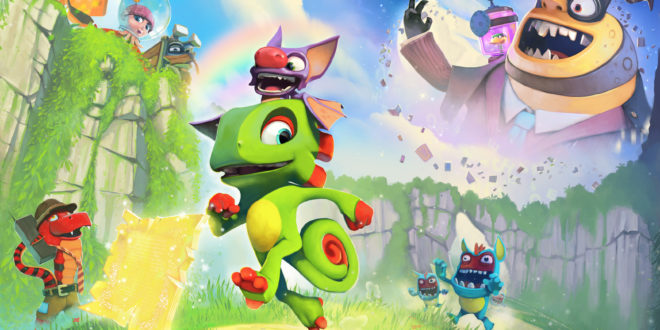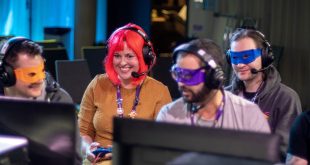Yooka-Laylee has the kind of story that we love to dissect here, with all the ingredients for a great When We Made: a well-known, experienced team coming from a beloved studio (Rare), an incredible heritage to build upon (Banjo-Kazooie), one of the most successful Kickstarter campaigns ever for a video game (over £2m raised)… And a somewhat trying release – or rather a two-step launch, with a big patch tidying up the issues a few months after release.

But one refreshing thing about talking to the team at developer Playtonic is that they’re not shying away from the setbacks Yooka-Laylee experienced at launch, instead using these to provide insights on the life of a Kickstarted studio and the pressure that entails.
But we’re trying to run before we can walk here – let’s first go back to Yooka Laylee’s inception.
“We had a bunch of different ideas but one of them was to really revisit things from the games that we love from the past and try to bring them back,” starts Chris Sutherland, Playtonic’s co-founder, Yooka-Laylee’s project director and software engineer, and a Rare veteran (as well as the voice of Banjo, Kazooie, Yooka and Laylee!). “We believed there was a demand, seeing what people were saying on Twitter and other platforms online. So we thought: these games do have an audience and we’d like to bring them back.”
The underlying concept was easy to decide then, but the specifics were trickier, with one of the core questions being to choose between 2D and 3D.
“We had to weigh up these things in terms of technical complexity and the size of the team and we should have picked the simpler one to do first,” Sutherland laughs, hinting at The Impossible Lair, Yooka-Laylee’s largely 2D spin-off that the team has just announced. So why start with 3D then?

“We thought that it would resonate with people more because there weren’t that many of those kind of games out there,” Sutherland says. “Collectathons seem to have dissipated or maybe more mature games now had those aspects in them. But they vanished as a thing in themselves so there was a gap in the market and we talked about how it would help to stand out more if we made that game then.”
So that’s what the team set up to do. A ‘Rare-vival’ they called it – a 3D platformer that’d be a spiritual sequel to Banjo-Kazooie. And it turned out that they were right: people did really, really want that game. But that came with unexpected consequences.
RARE-VIVAL
There were a few gameplay and design pillars that were firmly implanted in Banjo-Kazooie that Playtonic really wanted to recreate in Yooka-Laylee: “One of them was the humour and the fact that it was fun to play on different levels – the text and the voices, the noises the characters make, there’s a kind of underlying humour there, a silliness that we wanted to bring back to people,” Sutherland says.

Technical art director Mark Stevenson adds: “One of the big pillars for us was characters. Back in the Rare days, our games were very character-based and one of the pillars going forward for [Playtonic] is to create a universe with characters, to see those characters again and again in different games. Each one has the potential to star in a game.”
Designer Hamish Lockwood joined Playtonic about a year after its inception, he tells us, and worked on Yooka-Laylee for a year until its launch in April 2017.
When talking about the game’s pillars, he mentions the exploration of these large worlds, “collecting a lot of crazy stuff and talking to a lot of weird creatures” as well as the humour Sutherland already mentioned.

He continues: “They were definitely things that we tried to push throughout the game. And then as we developed it, we were trying to streamline a lot of the older mechanics. Like in previous games there were a lot of – in fact, possibly too many – collectibles, so we tried to streamline that, and have the energy bar and then just write out a few different things. But certainly taking Banjo as the blueprint.”
Sutherland takes over: “We obviously tried to capture the feel of the original, with the characters, and the characters’ controls… I was trying to have something that felt familiar to people.
“Where it didn’t work so well maybe was the camera because we were trying to bring back the style of the camera that we had when those first 3D games were coming out… The cameras tended to take the approach of trying to sort things out for you and trying to position themselves in intelligent places.
“So we went along that route because the way the camera frames the player [is part of the] feel of these games. But the way that works means it could actually end up disorientating the player and I think that’s something that we realised maybe slightly later on.
“Maybe it’s just because there wasn’t the internet back then so people couldn’t tell us how much they hated things.”
“We addressed it in a patch where we introduced different camera options so people could take control, as people now do with cameras in most 3D environments. If we were going back and redoing it all over again we would probably start off with the other camera options in there.”
The camera was one of two key criticisms around Yooka-Laylee’s launch with the other being the characters’ voices. Such early criticism could have easily been seen as unjustified or going against what the team was trying to achieve. But that’s not how they saw it, as Sutherland explains.
“If someone has an issue with something then I can’t say it’s unfair if that’s how they felt. They felt that for a reason so I often try to think about why that is,” he says. “So we had that with the camera and with the voices as well. It was interesting because it’s something that back in the 1990s was probably amusing people and it didn’t irritate them so much. Or maybe it’s just because there wasn’t the internet back then so people couldn’t tell us how much they hated things,” he laughs.
“It was again something that we addressed in the patch. It was interesting because some people said: ‘Oh it’s great because it recreates the original feel’ and that’s one of the things we were going for but at the same we didn’t want to wind people up either so we had an option in the update that allowed for a more restrained form of the voices than the one we shipped with.”
Stevenson adds: “I guess things have moved on so much since then. Voice acting is very much the norm now and maybe they saw it as a backwards step. The other thing is a lot of the fans, that were funding this project into life, were kids when they were playing [Banjo-Kazooie] so I don’t know, maybe their tastes have changed,” he laughs.

This highlights a very interesting aspect of Yooka-Laylee’s journey: Playtonic worked hard to create a game that would feel like the good old Banjo-Kazooie era. Over 73,000 backers gave money so they could do exactly that. And yet the game was under criticism for… creating a game that would feel like the good old Banjo-Kazooie era. While that certainly doesn’t mean that Yooka-Laylee was perfect at launch, it’s an intriguing dilemma. And while he accepts and agrees with criticism, Lockwood does admit he was a bit surprised by some of it.
“A lot of the criticism we probably expected and were aware of from the day it came out. We all knew where the issues were. Mostly because we didn’t have a lot of time to do everything that we wanted and how we wanted it. So a lot of criticism people had we probably agree with.
“I think one of the only things that did surprise me was the voices because as I was playing I was like: ‘Yeah this is fine it’s just like what the old one used to be’ – and that’s kind of the point of this game. So the voice thing for me was a surprise but a lot of the other criticism I just accepted and that’s fine. It was a tough project I think.”
This is the first mention of another challenge Playtonic met during development: time constraint. And that’s one of the massive downsides of having such a successful Kickstarter campaign.
THINK TWICE
When we ask the team if the Kickstarter campaign added a bit of pressure, as people were following the development of Yooka-Laylee very closely, Sutherland immediately says “yes” with a smile and it’s the most genuine and tired yes I’ve heard in a long while.
“The games that we worked on in the past, we just used to sit in a room for years building something and then we’d go: ‘Here it is!’ What you are not used to doing is going: ‘Oh, we’ve done this now, have a look at this’. That can be great if people like what you’ve done but they don’t often see it in context of the full game. So sometimes people might react to something that you’ve thrown online and then [if people react] negatively you have to change it. It’s just a different way of working that we weren’t quite familiar with,” he explains.
On top of the pressure to deliver exactly what people expected them to deliver, Playtonic was also drowning in tasks that had nothing to do with games development.
“It was an enormous amount of pressure I think,” Stevenson starts saying. ”There’s lots of other things work-wise, like having to provide regular updates to the community, and all the rewards that we had to produce in-house like booklets, posters, T-shirts… I had to produce artwork ready for print, something I’d never done before in my life!
“So everybody was just all hands on deck with all this different stuff that we did have to come up with on top of making the game and I look back at the game now, look at the size of it… Roughly we have made that game with what would be an average of 15 people for two years and I think: ‘How the heck did we do that?!’”
“We made all these [Kickstarter] promises and trying to keep those in the game in some form made the development quite difficult.”
The three colleagues then burst out laughing, sharing memories of all these mundane tasks they had to do – they’re joking about it now but it’s pretty clear that it wasn’t all a labour of love back then.
Sutherland reminisces: “We were using a shipping container to store something like 6,000 T-shirts and I remember taking delivery of those and having to put these boxes in the shipping container and then coming in on the weekend because we needed them to be in a particular order so we sorted them out and shuffled them around and took some boxes and counted them all up and then listed them all in a spreadsheet…”
Lockwood adds with a grin: “There were days where we would all go into these rooms and sort out all the T-shirts because they all had to be in groups of large and small or whatever. That was time where I could have been working on the game!”
So it doesn’t come out as too much of a surprise when we ask the team for some advice for fellow developers who are tempted by a Kickstarter campaign that Sutherland replies that they should first “really think carefully about doing it.” They all start laughing again and it’s all very good-natured and obvious there’s no hard feelings here but it’s also obvious that Playtonic probably won’t turn to crowdfunding again for quite a while.
Sutherland continues: “[If you’re doing a Kickstarter campaign] I’d probably not promise too much because if you promise many things – particularly lots of physical things like T-shirts – it’s quite likely that the point you’re going to be producing those could well be the point where you’d like to ship the game. Try not to do that at the same time. It ended up at the same time for us for various reasons and we’d try to avoid that in the future and get things out of the way or just find someone we can partner with so they can do that stuff for us. But of course we just thought we could do all this ourselves,” he smiles.

Lockwood adds: “If I were to do one myself I would say: ‘This is the game we want to make. We’re not going to make any promises other than we want to make this game so any money goes into the development of the game and making it as good as can be’. Whereas with the Kickstarter we did we made all these promises and trying to keep those in the game in some form made the development quite difficult.
“For example we did bosses and minecart sections as well as arcade games – all these extra things where, if we hadn’t made any of these promises, we could say: ‘You know what, this isn’t really working so well so we’ll just ditch it and spend more time on the more core areas of the game’.”
Stevenson is very much in agreement: “That’s one of the worst aspects. You have to promise stuff up front and then you’re kind of commited to it. For better or worse. With games it’s an inherent difficulty that what sounds great on paper may not work that well in practice and often times things have to be iterated on again and again or even just scrapped. One of the worst things as well is that Kickstarter requires you to put a launch date on. So I would advise people to be very conservative with that because it puts so much pressure and expectation on you.”
With The Impossible Lair, it looks like the development has been much more relaxed. There’s no Kickstarter to add pressure and when Playtonic announced the Yooka-Laylee spin-off, it’s interesting to see that the studio didn’t set a release date beyond a vague ‘2019’.
“I think making a less ambitious game with more people allows it to be just a better game in all areas.”
But that’s not the only thing the team learnt from developing Yooka-Laylee, as Sutherland highlights.
“There’s lots of small things that we’ve learnt in terms of how we organise ourselves, organise our work. As the team’s grown in size, we try to be more organised and coordinated in the things that we’re doing,” he says.
Lockwood mentions how they can also be much more focused on this new title: “I think making a less ambitious game with more people allows it to be just a better game in all areas. Like Mark said before, we had so many different things to do with so few people in such a short amount of time that it spread us thin. Whereas with this one we can really focus on making everything really good and taking all the time it needs, announcing it when it’s much much closer to finished.”
Stevenson adds that they’ve learnt about staffing requirements as well, with Playtonic now having a full time producer which it didn’t have for the first game as well as a full time community person and someone “that just deals with all the non development stuff.”
It very much sounds like Playtonic is in a perfect position to deliver the spin-off Yooka-Laylee deserves.

 MCV/DEVELOP News, events, research and jobs from the games industry
MCV/DEVELOP News, events, research and jobs from the games industry




